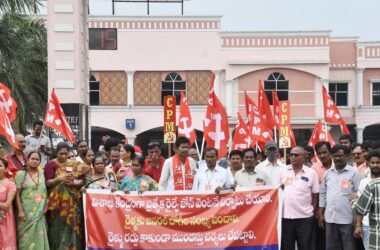“(Discount in finances allocation for larger schooling) will contribute to the exacerbation of the financial burden on each academic establishments and college students” File
| Picture Credit score: The Hindu
The Interim Finances that includes a considerable lower of over 60% in allocations to the College Grants Fee (UGC) serves as a scathing reminder of Jacob J. Lew’s proposition that “the finances is not only a group of numbers, however an expression of our values and aspirations”. The grant for larger schooling has suffered a ruthless discount of ₹9,600 crore from the previous fiscal 12 months’s revised estimate, with a second consecutive 12 months of slashes in allocations for establishments such because the Indian Institutes of Expertise and and the Indian Institutes of Administration.
This budgetary pattern raises questions on its alignment with the overarching targets of ‘Schooling 2023: Incheon Declaration,’ championed by India, in search of inclusive, equitable, and high quality studying for all although a focused allocation of 4-6% of the nation’s GDP. The Interim Finances marks a retrenchment from the lofty ambitions of the Incheon Declaration, with the present allocation standing at roughly 2.8% of the GDP.
Financial burden
Whereas there’s a marginal improve of 0.73% to highschool schooling, the Interim Finances has unflinchingly slashed the allocation to larger schooling by 16.8%. This may contribute to the exacerbation of the financial burden on each academic establishments and college students. Regardless of the finances asserting a 28% improve in funding for Central universities, it’s noteworthy that it’s directed to not the UGC however to the Greater Schooling Financing Company (HEFA). Established as a collaborative enterprise between Canara Financial institution and the Ministry of Schooling, HEFA affords monetary help for the event and enhancement of schooling infrastructure via the availability of loans. This institution has left the ‘G’ in UGC, which stands for Grants, trying to find relevance, decreasing it to nothing greater than a statutory and regulatory physique, fervently championing company values and beliefs that revolve round minimising prices and maximising income. This is not going to solely compel faculties and universities to introduce extra self-financing programs but in addition improve the monetary woes of scholars and these establishments’ reliance on the goodwill (learn: loans) of the ‘benevolent’ HEFA. This flagrant transference of monetary duty from the federal government to public establishments and their college students compels universities, as soon as revered as temples of data, to don the cloak of monetary stewardship, steering their central focus away from the pursuit of schooling. Schooling, on this paradigm, turns into a purchasable commodity procured via loans, obliging universities to repay through internally generated funds, sometimes sourced by charging college students increasingly more.
This encumbrance will worsen the already precarious academic situation of marginalised teams, as their Gross Enrolment Ratio (GER) falls considerably under the nationwide common of 27.3%, with ladies, Scheduled Castes, and Scheduled Tribes registering a GER of 24.9%, 23.1%, and 18.9%, respectively (as reported by the All India Survey on Greater Schooling 2020-21). With the GER on the elementary stage standing impressively at nearly 100% (as reported by the Division of Faculty Schooling and Literacy Survey 2021-22), a sobering actuality surfaces, revealing that over 72% of scholars discover themselves excluded from the prospect of upper schooling, primarily as a result of fiscal deficit skilled by establishments and college students. Regardless of the Central authorities’s grandiose declaration and fanfare of this era because the ‘Amrit Kaal’ of India’s growth, it’s noteworthy that India’s GER on the larger schooling stage trails considerably behind the worldwide common of 38%, marking it the bottom amongst BRICS nations. Regrettably, no Amrit or nectar, other than a considerable budgetary allocation, can rejuvenate this ailing academic panorama. Sturdy funding stands as a vital linchpin, propelling initiatives to bridge gaps, improve enrolments, guarantee retention, and elevate the general high quality of schooling, making it extra equitable and inclusive.
Allocation to highschool schooling
However even the marginal allocation to the Division of Faculty Schooling and Literacy carries a snag. A big share of the allocation of ₹73,000 crore, particularly ₹6,050 crore, has been allotted to improve 6,448 PM-Colleges for Rising India (PM-SHRI), whereas ₹6,399 crore has been earmarked for the development of latest Eklavya Mannequin Residential Colleges (EMRS), indicating a rise of ₹3,250 crore and ₹3,930 crore, respectively, from the earlier 12 months’s Finances. This factors to a state of affairs the place 8.3% of the full faculty schooling finances is devoted completely to a mere 0.7% of faculties, resulting in a considerable lower within the general finances for current faculties and leaving them within the lurch.
The PM-SHRI faculties adhere to the directives of the Nationwide Schooling Coverage (NEP) 2020. The upper budgetary allocation to them appears to be a means of arm-twisting faculties from different States/Union Territories who’re sceptical concerning the NEP agenda to embrace it in its entirety. The intricate inquiry into how NEP 2020 institutionalises numerous socio-economic inequalities and exacerbates pre-existing academic challenges, whereas abstaining from its duty and accountability in the direction of deprived and marginalised social teams, is a query that considerations not solely these States/Union Territories but in addition each different analytical thoughts.
Anamica is pursuing a PhD in schooling from IIT Bombay-Monash College; Navneet Sharma teaches within the Division of Schooling on the Central College of Himachal Pradesh, Dharamsala






